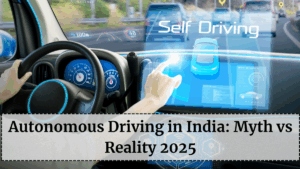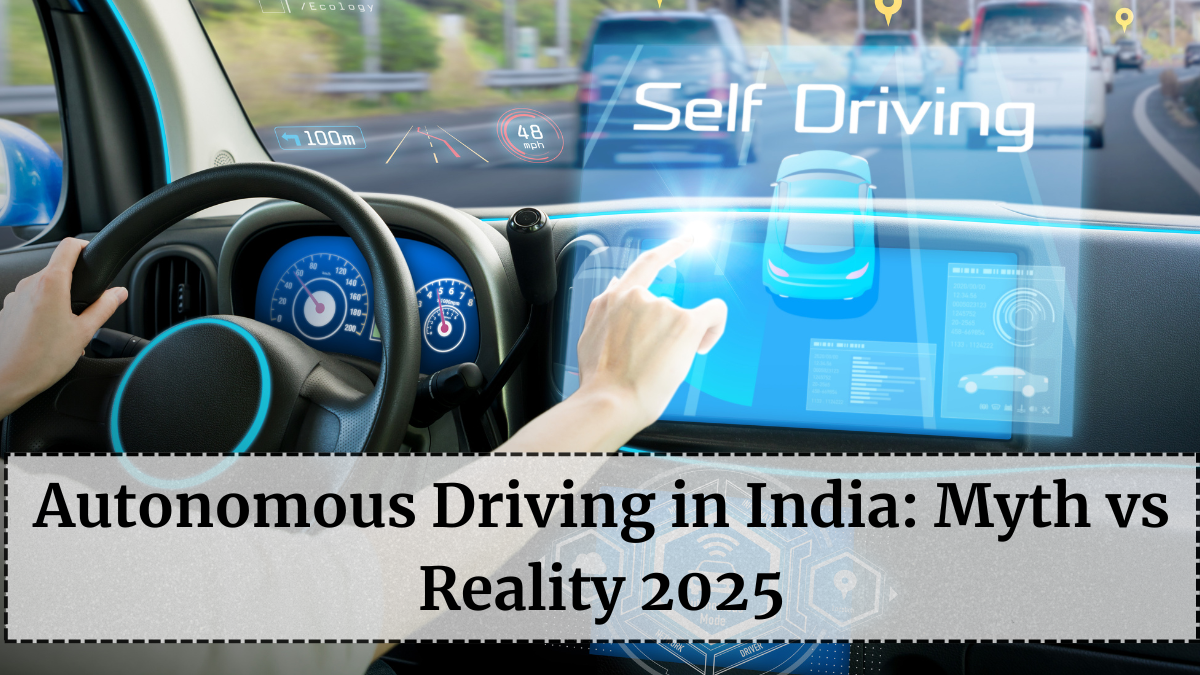The global auto industry is rapidly moving toward autonomous driving, where cars can think, react, and drive with minimal human input. However, when it comes to Autonomous Driving in India 2025, the road is far more complex. While global giants like Tesla and Waymo are testing fully self-driving cars abroad, India faces unique challenges that make complete automation a distant goal — at least for now.
Let’s explore the real progress, limitations, and future possibilities of autonomous driving in India as we separate myth from reality.

The Concept of Autonomous Driving
What Is an Autonomous Vehicle?
An autonomous vehicle (AV) uses a combination of Artificial Intelligence (AI), sensors, radar, cameras, and GPS to navigate roads and make decisions like a human driver. These systems analyze surroundings in real time — identifying pedestrians, vehicles, and signals — to control acceleration, braking, and steering automatically.
Levels of Vehicle Autonomy
The Society of Automotive Engineers (SAE) defines six levels of driving automation:
-
Level 0: No automation (driver controls everything)
-
Level 1: Driver assistance (cruise control, lane assist)
-
Level 2: Partial automation (ADAS features control braking and steering)
-
Level 3: Conditional automation (car can drive itself in limited conditions)
-
Level 4: High automation (car can drive without human input in most situations)
-
Level 5: Full automation (no steering wheel or pedals required)
India currently operates at Level 2, with some advanced models experimenting with Level 3 capabilities.
The Reality of Autonomous Driving in India
Current Technology Status
India’s automakers — including Tata Motors, Mahindra, and Hyundai — are adopting ADAS (Advanced Driver Assistance Systems) in their premium vehicles. These systems include adaptive cruise control, collision avoidance, and lane departure warnings. However, fully autonomous cars are not yet road-ready due to unpredictable traffic conditions, limited digital mapping, and infrastructure gaps.
Challenges Slowing Down Adoption
-
Unpredictable Driving Behavior: Unlike the organized traffic in the US or Europe, Indian roads involve erratic lane changes, jaywalking, and non-standard driving patterns that confuse AI systems.
-
Poor Road Infrastructure: Lack of lane markings, uneven roads, and mixed-use highways make sensor accuracy unreliable.
-
Legal and Ethical Concerns: India currently lacks comprehensive autonomous driving regulations, liability laws, and ethical frameworks for AI-driven decision-making.
-
High Cost of Sensors and Data: Lidar and radar systems are expensive, and data collection at scale is still in early stages.
Government and Industry Initiatives
The Indian government has taken steps to encourage research in autonomous and connected mobility through organizations like NITI Aayog and the Ministry of Heavy Industries. Pilot testing for autonomous shuttles and smart mobility zones is already underway in cities like Bengaluru and Hyderabad.
Private automakers are also collaborating with tech companies such as Bosch, NVIDIA, and Tata Elxsi to develop adaptive software capable of Indian road conditions.
Myths About Autonomous Cars in India
Myth 1: Self-Driving Cars Will Arrive by 2025
Reality: Full self-driving cars (Level 5) are not expected in India before 2030–2035. Current models in 2025 are semi-autonomous and rely heavily on human supervision.
Myth 2: AI Can Handle Indian Traffic Chaos
Reality: AI systems need consistent patterns to learn, and India’s dynamic traffic behavior makes it extremely challenging to predict. Ongoing trials are improving recognition of two-wheelers, street vendors, and animals, but reliability remains low.
Myth 3: Autonomous Cars Don’t Need Maps
Reality: Real-time HD mapping is crucial for autonomous navigation. India’s map accuracy still lags behind Western nations, limiting large-scale deployment of AVs.
The Path Forward – India’s Semi-Autonomous Future
Focus on Assisted Driving
India’s journey toward autonomy will start with semi-autonomous systems. Cars like the MG Gloster, Hyundai Tucson, and Mahindra XUV700 already include ADAS features that make driving safer, not driver-free.
Role of AI and 5G
With the rollout of 5G networks, vehicles will soon communicate with each other and the environment, improving decision-making and reducing reaction times. AI will process real-time data faster, enhancing safety for both drivers and pedestrians.
Electric + Autonomous Integration
Electric vehicles and autonomous systems will grow hand-in-hand. EVs already have centralized software architecture, making them ideal for future self-driving upgrades through OTA updates.
Global vs Indian Scenario
In countries like the US, Japan, and Germany, driverless taxis and delivery bots are already being tested. In contrast, India’s roadmap involves gradual evolution — starting with connected mobility, sensor-based assistance, and smart infrastructure development. While the technology gap exists, the adaptation speed is improving.
By 2025, India won’t have driverless roads, but it will have intelligent cars capable of assisting drivers, avoiding accidents, and reducing fatigue.
FAQs
Are autonomous cars legal in India?
Not yet. India has no official laws for self-driving vehicles, though testing is allowed in controlled environments and private campuses.
Which car brands offer autonomous features in India?
Brands like MG, Hyundai, Mahindra, and Honda offer Level 2 driver-assistance systems in select premium models.
When will India get fully autonomous cars?
Full automation (Level 5) is expected only after 2030, depending on policy, infrastructure, and AI development.
What technologies power self-driving cars?
Autonomous cars rely on AI algorithms, cameras, radar, Lidar sensors, GPS, and 5G communication to make real-time driving decisions.
Can Indian roads support autonomous driving?
Not yet fully. Roads need consistent lane markings, better signage, and high-definition mapping to make autonomous driving viable across the country.
Click here to know more.
